
Mamie Eisenhower listens attentively to her husband’s 1959 State of the Union speech.
Tomorrow’s State of the Union Address, delivered by President Barack Obama on Capitol Hill, may seem like it has always been a part of American life, but in fact it is one custom of the American Presidencybegun by George Washington that was cut short just two Presidents later, by Thomas Jefferson. He thought it seemed too monarchical, and just sent a printed version to Congress. Next year – 2013 – marks the centennial of the custom as continuous, revived by Woodrow Wilson.

First Lady Michelle Obama at the 2012 State of the Union Address. (Reuters – Reed)
Behind the scenes and in public, First Ladies have played a part in the State of the Union Addresses.
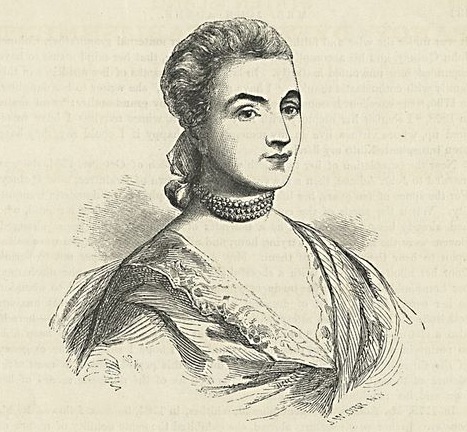
Abigail Adams.
No documentation shows Martha Washington attending any of her husband’s annual “Messages to Congress.” Although absent from the scene for much of her husband’s presidency, Abigail Adams (First Lady, March 4, 1797 – March 4, 1801) wrote her assessment of John Adams’s third State of the Union, on December 3, 1799, opining that it would prove unpopular due to his keeping the U.S. neutral in unrest in France. “They will grumble at all events and under all circumstances, and so let them,” she philosophized. She was therefor delighted that the House and Senate received the speech “with more applause and approbation than any speech which the President has ever delivered.” As for the traditional reply of the Senate to the President, she was certain it was drafted by a New Englander because it quoted Scripture and, she added, “no Southern man ever quotes Scripture.” Despite her public reputation as the President’s political adviser and a sharply partisan Federalist in her own right, the First Lady felt it was improper for her to attend the President’s speech sending instead her daughter Nabby Smith to sit in the audience and report back her observations.
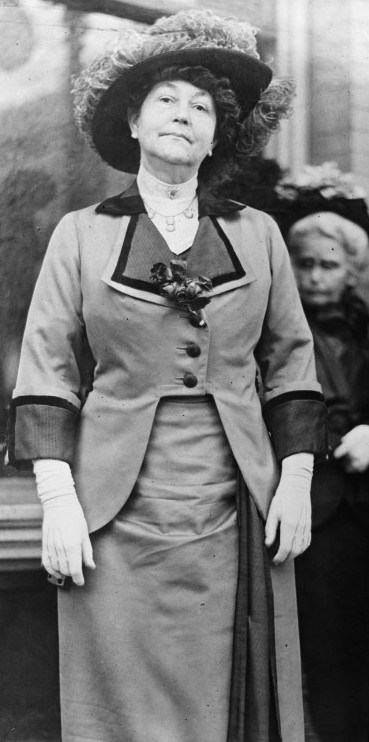
First Lady Ellen Wilson leaving hte U.S. Capitol Building.
One month and four days after becoming President, Woodrow Wilson broke the long precedent set by Jefferson. On April 8, 1913 he became the first since Adams to deliver the Presidential Message to Congress in person. Former President Theodore Roosevelt, among many others, was astonished at what he viewed as arrogance and later railed that Wilson was “selfish and cold-blooded politician” and an “doctrinaire” who put his “personal ambition” above all else. Ellen Wilson, (First Lady, March 4, 1913- August 14, 1914) with whom the President had a long history of first reviewing his public statements, was there to proudly witness the event. It was Ellen Wilson who had, in fact, urged him to revive the custom and thus some credit for the annual event is due to her. As she was leaving the Capital she remarked that it was “the kind of thing that Theodore Roosevelt would have liked to do – if he’d thought of it first.”
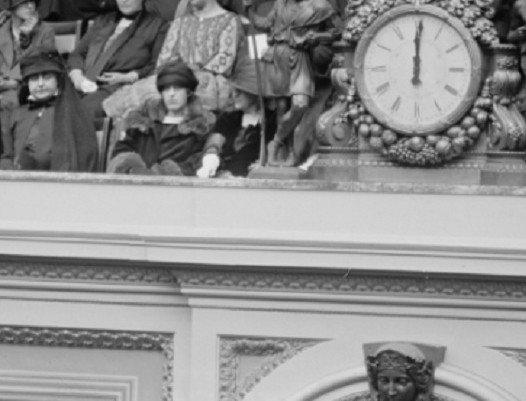
Edith Wilson (far left) and her stepdaughter Margaret Wilson at the 1917 State of the Union Address.
By coincidence, on that same night in the same chamber, the woman who would, in 32 months, become the second wife of Woodrow Wilson, Edith Bolling Galt Wilson, (First Lady, December 15, 1915 – March 4, 1921) was also in attendance and focused on him. After coaxing a Capitol Building police guard into letting her in without the required ticket so she could hear Wilson speak, there was a “definite effort on my part,” she recalled, to get herself a front-row seat in the visitor’s gallery. Directly above the speaker’s rostrum, she had a close-up view of Wilson. As First Lady Edith Wilson would rarely ever leave the side of the President at any of his public events and she sat prominently with the wives of Cabinet members and Democratic Senate and House leaders to listen to all of Wilson’s State of the Union Addresses after her marriage. Curiously, even after she was Wilson’s wife in her own right, she still sat above the rostrum, often with one of the President’s daughters by his first marriage.
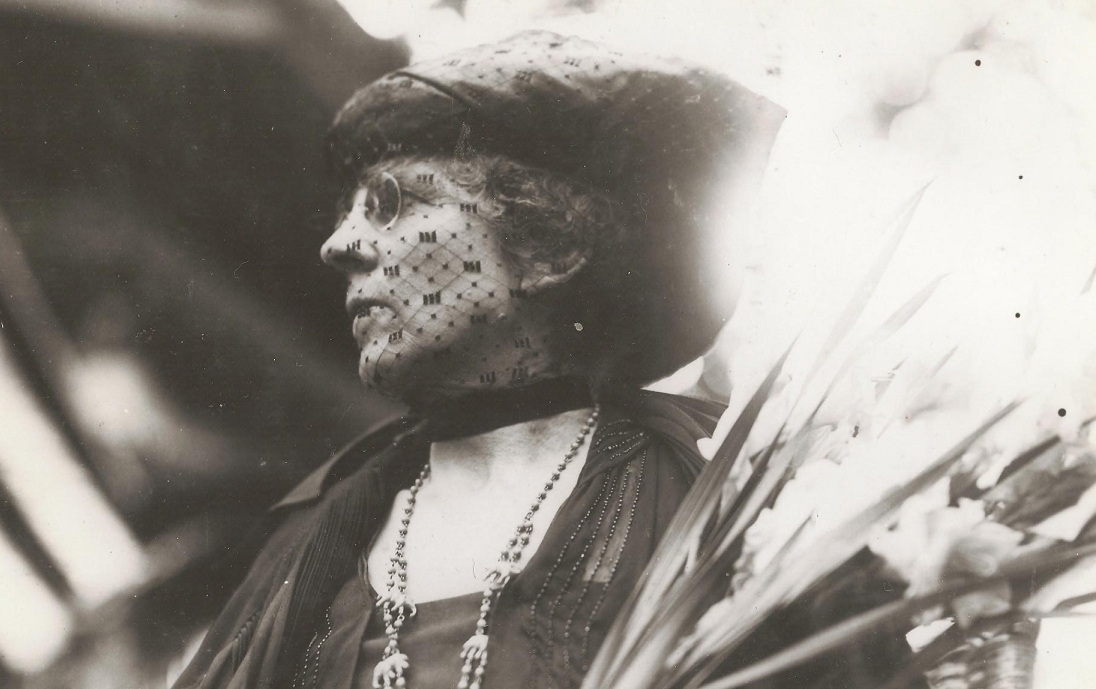
Florence Harding.
Few First Ladies were as overtly involved in presidential policy as was Florence Harding (First Lady, March 4, 1921 – August 2, 1923). Having helped shape the anti-League of Nations stance of the successful presidential campaign of her husband, Warren Harding, she vigorously held him to that view.

Harry Daughtery (far left) at the White House.
As Harding read a draft of his 1921 State of the Union speech to his Attorney-General Harry Daugherty in the Oval Office, Daugherty grew alarmed that he implied eventual acceptance of the League. He went directly to the First Lady and was present at a heated argument between the couple. The First Lady insisted the President remove the paragraphs in question and by the time Daugherty left, Harding had not budged. Listening to the State of the Union along with Interior Secretary Albert Fall, Daugherty was shocked when the place came for the intended paragraph: Florence Harding had prevailed. “A wise little woman,” remarked Fall. Presidential speechwriter Judson Welliver further recalled an incident where Florence Harding came into the Oval Office, read through a draft of Harding’s State of the Union for either 1922 or 1923 – and refused to leave until he removed a proposal to Congress of a one-term six-year presidency that would remove the Chief Executive from the partisan politics necessary to winning a second term. She again succeeded.
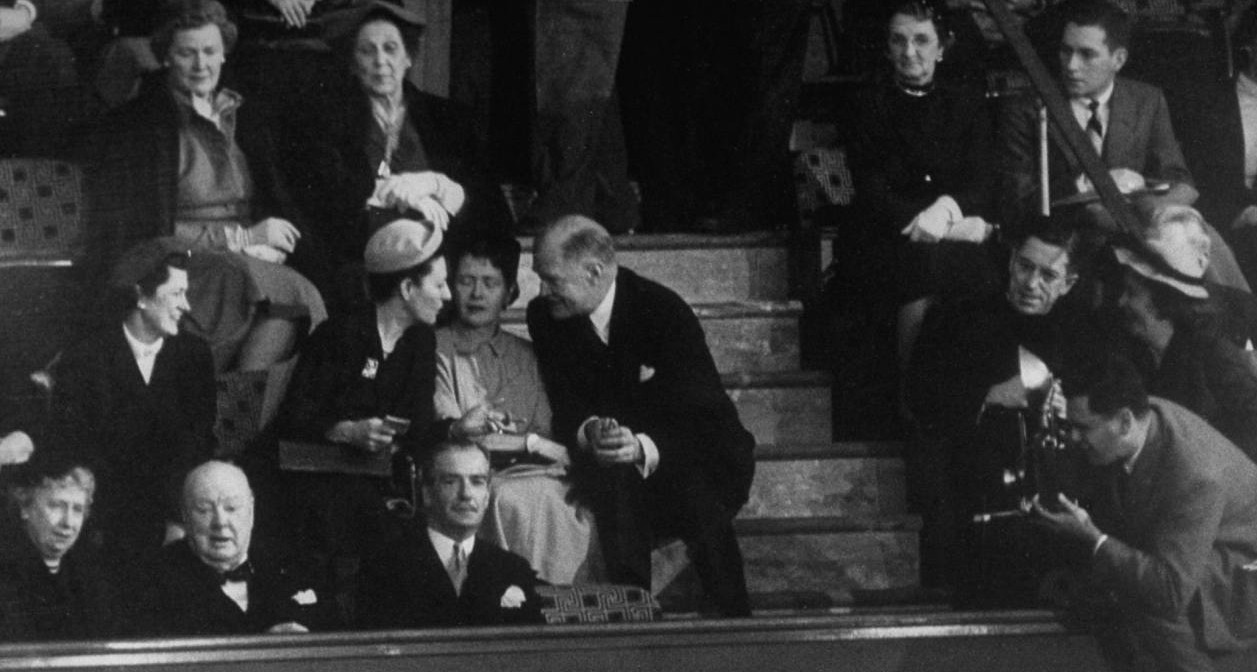
In the lower left corner, Bess Truman with British Prime Minister Winston Churchill, attending the 1952 State of the Union Address.
Succeeding First Ladies did not always attend every one of their husbands’ State of the Union Addresses, nor when they did were they always the object of all eyes, often taking a seat several rows back, among other invited guests. The appearance of Bess Truman with British Prime Minister Winston Churchill, at Harry Truman’s 1952 State of the Union Address, however, brought the usually publicity-adverse First Lady into the spotlight, since it was one of the first to be shown live on television, a relatively new medium in most American homes. Since then, First Ladies have usually been a central figure for the television cameras, while waiting for the President to arrive.
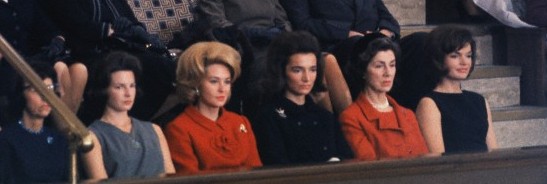
Jackie Kennedy at the 1963 State of the Union Address with (right to left) her mother Janet Auchincloss, sister Lee Radziwill, sister-in-law Joan Kennedy, her press secretary Pam Turnure and the President’s secretary Evalyn Lincoln (partially obscured)..
When Jacqueline Kennedy (First Lady, January 20, 1961 – November 22, 1963) attended her husband’s State of the Union Address, she often invited women relatives who also lived in Washington like her mother, half-sister, or Kennedy sisters-in-law. Jacqueline Kennedy often turned her attention from the President’s speech to note the reaction of members of Congress below to various parts of the speech, especially proposed funding for the space program and an education bill. A friend recalled, “She follows every roll-call in the Congressional Record. She is intensely loyal to Jack and resents votes against his programs.” While being driven through town she spotted a Republican senator who had voted against an initial funding initiative on education and had her driver pull up to him by the curb, rolled her window down and shouted, “I thought you were going to be nice to us, because if you’re not I won’t let you take out my secretary anymore.”
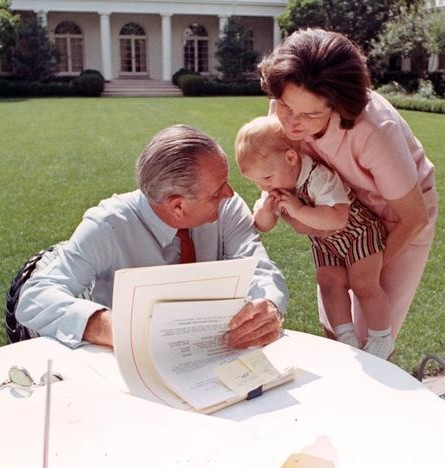
Lady Bird Johnson brings her grandson Lyn over to the President while he works on a speech outside the Oval Office.
The last months of Lyndon Johnson‘s presidency were fraught with the trauma of the Vietnam War and many of the former colleagues of LBJ in the House and Senate with whom he had become friends, now withdrew much of their support for him. At his last State of the Union Address, Lady Bird Johnson (First Lady, November 22, 1963- January 20, 1969) sat with her daughters Lynda Robb and Luci Nugent, and the latter’s child, the President’s first grandchild, Lyn Nugent. two years old at the time. Suddenly, without warning, the toddler began banging his bottle against the railing – below which sat the august and humorless members of the U.S. Senate. He then began shouting as babies will, turning the heads of the legislators up towards the president’s family. The usually composed First Lady couldn’t help bursting into laughter, relieving some of the political tension she felt that night, as Luci Nugent finally slipped out with her son. In his 1964 address, LBJ became the first president to make passing reference to his wife, recalling their international travel during his vice presidential years and the goodwill towards the United States they had encountered. His later exhortations on behalf of environmental protection legislation was a direct result of her influence, some suggesting she even had the right-to-review those passages dealing with her “project.”

Rosalynn Carter testifies before Senate, February 7, 1979
Jimmy Carter was one of the first Presidents to acknowledge his tremendous reliance on his wife for her political input, opinion and suggestions. Indeed Rosalynn Carter (First Lady, January 20, 1977 – January 20, 1981) made it her business to not only initiate several domestic but international efforts on behalf of the Administration. She often traveled the nation and spoke with common citizens about their reaction to policy and concerns. In that context, she attended Cabinet meetings so she could take notes and hear firsthand the issues on the Administration’s agenda and then carry it out herself in speeches. Both the President and First Lady thus openly acknowledged that on the day before his 1978 State of the Union Address, in their bedroom suite in the White House, Rosalynn Carter carefully went over the final draft of the intended speech, suggesting changes and additions, some of which he incorporated. The President said that because she understood issues “from the viewpoint of the average American, I don’t mind her criticizing my speeches.”

Nancy Reagan at the 1982 State of the Union Address applauds Larry Skutnik, the hero who saved people from a plane that landed in the Potomac River.
It was during the Reagan years that the custom began of inviting special guests to sit with the First Lady in the V.I.P. Gallery above, regular citizens or prominent figures, who exemplified a point or a program that the President was referring to in his speech. According to the sharp memoir of Ronald Reagan’s Chief of Staff Donald Reagan, Nancy Reagan (January 20, 1981 – January 20, 1989) influenced the date of her husband’s 1987 State of the Union Address, based on astrological readings chosen as the best possible day to deliver it, in terms of his physical well-being. Regan further stated that the First Lady significantly influenced the content of the President’s January 1987 State of the Union Address, to avoid contentious partisan issues and focus instead on building the Reagan legacy.
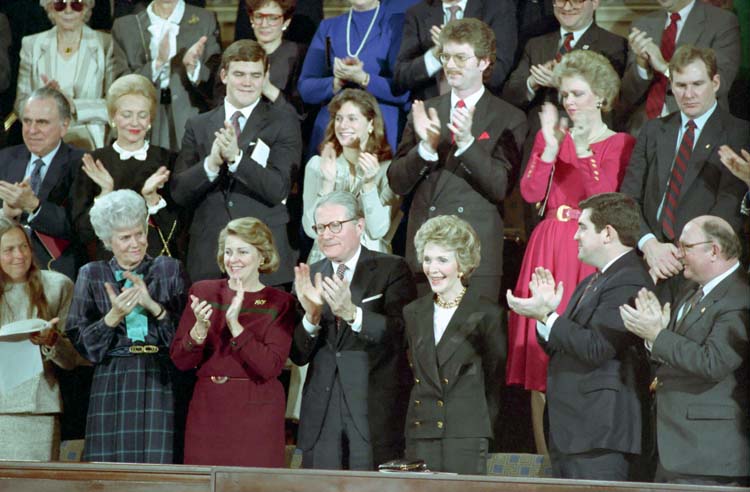
In 1988, At her husband’s last State of the Union Address, Nancy Reagan is applauded; with her was her stepbrother and his wife and daughter, and the President’s daughter Maurreen.
In 1988, Ronald Reagan also became the first president to bring attention to his wife by referring – he called her by her first name – to her project work, as it related to the larger Administration agenda. “The war against drugs is a war of individual battles, a crusade with many heroes — including America’s young people, and also someone very special to me,” Reagan said. “She has helped so many of our young people to say ‘no’ to drugs. Nancy, much credit belongs to you, and I want to express to you your husband’s pride and your country’s thanks. Surprised you, didn’t I?”

Barbara Bush with daughter Doro at the State of the Uniion Speech.
George Bush followed suit. In his 1992 State of the Union Address, he referred to his wife Barbara Bush (First Lady, January 20, 1989 – January 20, 1993) in the context of the Administration’s emphasis on family-related policy. He stated: “And finally, we must strengthen the family, because it is the family that has the greatest bearing on our future. When Barbara holds an AIDS baby in her arms and reads to children, she’s saying to every person in this country, ‘family matters.'”
Perhaps the most unusual role that might have been played by a First Lady at a State of the Union Address was in 2001, the first month of which was the last weeks of the Clinton Administration – but also marked the start of the U.S. Senate term of the only presidential wife elected to office in her own right, when Hillary Clinton became the Senator from New York.
For the first twenty days of 2001- until Bush’s Inaugural, she was both the Chief Executive’s spouse and a member of Congress.
For the previous seven years, Hillary Clinton (January 20, 1993-January 20, 2001) had a notable presence at the State of the Union Addresses. Seated is the traditional gallery seats aside for the First Lady, she was often flanked by a wide variety of American citizens working on numerous projects or symbolizing various program.

Hillary Clinton with her daughter at the 1996 State of the Union Address.
Certainly from the rostrum itself, however, no First Lady was more frequently evoked in a State of the Union Address than was Hillary Clinton. In 1994, the President made reference to her efforts to devise the Administration’s proposed health care reform, and read part of a letter a Nevada couple had sent her, chronicling the financial struggles that followed their health emergencies. In his 1996 speech, Clinton took a moment to make an unprecedented remark acknowledging just how influential his wife had been on him: “…to thank the person who has taught me more than anyone else over 25 years about the importance of families and children — a wonderful wife, a magnificent mother and a great First Lady. Thank you, Hillary. The next year, he again raised the topic of her work on children’s issues, announcing, “The First Lady has spent years writing about this issue [of early childhood development], studying it. And she and I are going to convene a White House Conference on Early Learning and the Brain this spring, to explore how parents and educators can best use these startling new findings.”

As U.S. Senator, Hillary Clinton attended George W. Bush’s 2008 State of the Union Address.
In 1998, the President called attention to the First Lady three times: in reference to a trip they took to Sarajevo; her sponsorship of the first White House Conference on child care; the launch of her White House Millennium program to promote America’s creativity and innovation and preserve its heritage and culture. That year, two guests who sat with Hillary Clinton were a woman who had successfully gone from welfare to work under Clinton’s welfare reform bill and a U.S. Army Sergeant who had fought in Bosnia. In 1999, he mentioned the First Lady in two different contexts: her efforts to aid Central American and Caribbean nations in the aftermath of devastating hurricanes and her leadership of Save America’s Treasures, an historic preservation program. That year, seated with her were civil rights pioneer Rosa Parks and an Arkansas parent who had lost a child in a school shooting and had become a gun control advocate. In 2000, he mentioned her three times: her efforts to get the entertainment industry to develop one standard “v-chip” rating system for children; her Millennium Dinner with a lecture on the human genome project; and her success in drafting new foster care and adoption policy. He ended by saying, “I am forever grateful to the person who has led our efforts from the beginning, and who’s worked so tirelessly for children and families for 30 years now: my wife, Hillary.”
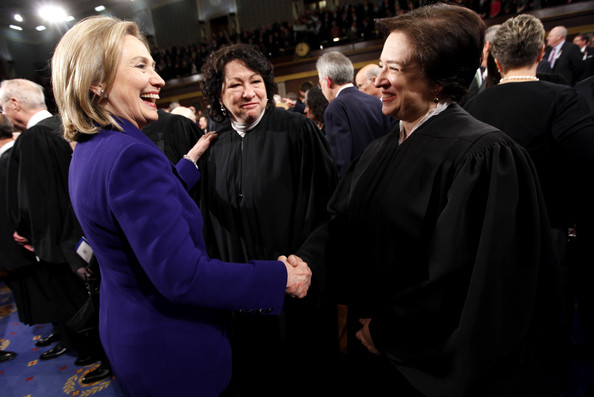
Secretary of State Hillary Clinton greets Supreme Court Justice Elena Kagan at President Obama’s 2011 State of the Union Address.
Hillary Clinton has listened to the Presidential State of the Union Address more times from the floor of the House than from the special guest viewing seats. As First Lady, she watched her husband’s speech seven times from the upper-seating. As a U.S. Senator, she watched her husband give one State of the Union and President George W. Bush eight times, and in her capacity as U.S. Secretary of State, she has watched President Barack Obama deliver two State of the Union Addresses, tomorrow marking a third time (she was in London for his 2009 speech).

Controversial Iraqi politician Ahmad Chalabi who fed false information to the U.S., encouraging the overthrow of Saddam Hussein, with Laura Bush at 2004 State of the Union Address.
George W. Bush became the fourth consecutive President to make reference to the symbolism, and project work of his wife. Following the terrorist attacks of September 11, 2001, Laura Bush (First Lady, January 20, 2001- present) made numerous appeals to parents to focus on their children and explain the crisis while also offering a sense of protection to them. As the President stated in his 2002 State of the Union Address, “And I hope you will join me — I hope you will join me in expressing thanks to one American for the strength and calm and comfort she brings to our nation in crisis, our First Lady, Laura Bush.”
In 2005, Bush talked about a “need to focus on giving young people, especially young men in our cities, better options than apathy, or gangs, or jail.” That night he proposed a three-year initiative to deter young men from joining gangs and propagating violence. “Taking on gang life will be one part of a broader outreach to at-risk youth, which involves parents and pastors, coaches and community leaders, in programs ranging from literacy to sports. And I’m proud that the leader of this nationwide effort will be our first lady, Laura Bush.”
At his 2010 State of the Union Address, President Obama went one step further in acknowledging the presence of First Lady Michelle Obama. After praising her anti-obesity campaign, he provoked a standing ovation for her, which she soon found embarrassing and mouthed the words for everyone to sit down. After they finally did, Obama teased her by quipping, “”She gets embarrassed.”
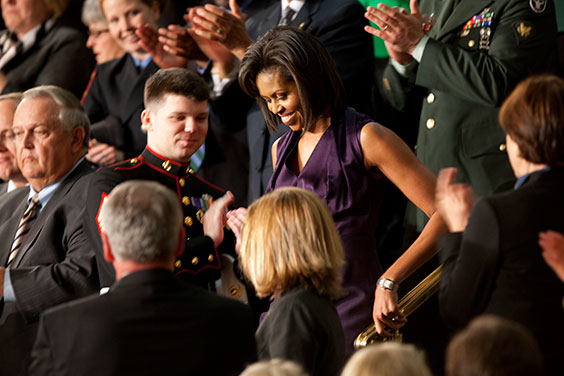
Michelle Obama at the 2010 State of the Union Address with Charles Archambault.
Related articles
- The State of the Union Is Inappropriate (nationalreview.com)
- Knowing Your Government: What You Should Know About The State Of The Union Address (praiserichmond.com)
- Liveblogging Obama’s State of the Union Address (swampland.time.com)
- Let’s Eliminate The State Of The Union Address (outsidethebeltway.com)
Categories: Barack Obama, First Ladies, First Ladies Public Image, Presidents, Ronald Reagan, The Wilsons, Theodore Roosevelt, Today in FLOTUS History
Tags: Barack Obama, First Lady, George Washington, Jacqueline Kennedy, Michelle Obama, Nancy Reagan, Ronald Reagan, State of the Union Address, Theodore Roosevelt
 Jackie & The Nixons: Mrs. Kennedy Returns to the White House, With New Images of the Visit
Jackie & The Nixons: Mrs. Kennedy Returns to the White House, With New Images of the Visit  Jane & Jill, Potential First Ladies: Lots in Common Between the Wives of Joe Biden & Bernie Sanders
Jane & Jill, Potential First Ladies: Lots in Common Between the Wives of Joe Biden & Bernie Sanders  The President as King: A Political Cartoon History
The President as King: A Political Cartoon History  All The Presidents’ Birthdays: Dance Balls to Movie Star Fundraisers in 90 Rare Photos
All The Presidents’ Birthdays: Dance Balls to Movie Star Fundraisers in 90 Rare Photos  Liz Taylor Meets Jackie Kennedy: Tabloid Fantasy to Chance Encounter & The Only Photos of Them Together, Part II
Liz Taylor Meets Jackie Kennedy: Tabloid Fantasy to Chance Encounter & The Only Photos of Them Together, Part II  Melania Trump v. John Kelly: First Ladies & West Wing Personnel, A Brief History
Melania Trump v. John Kelly: First Ladies & West Wing Personnel, A Brief History
You’ve just outdone yourself on this one kiddo! 🙂
Thanks G!
A very good overview. The 1st Ladies, especially in this day & age of playing the “fame game” have the ability to influence American Culture as much as they want to. Our current 1st lady seems to be a very outgoing extravert who wants to exert her influence as much as possible.. I just saw the quip on Newt Gingrich, that somebody entered:).
It’s going to be real interesting, IF Gingrich wins the election, as to how much his wife, who is already getting some negative feedback, is going to want the heat of that spotlight. While Michelle Obama is not beloved by everybody, she did not come into the WH with a load of serious baggage, the way Mrs. Gingrich might. I even wonder if “the Powers that Be”, would encourage her to remain quiet and in background, for much of 1st term. It is really a potentially toxic brew, all this technology in Journalism, and how invasive it is. There is quite a market for sleazy expose type journalism. We can get real self-righteous on this issue, agree that it’s disgusting to snoop so much, and it’s the American Public that demands these expose pieces, so many of us get quite a high, living vicariously through the gossip re these colorful figures. The “side shows” all these candidates bring along is truly amazing!